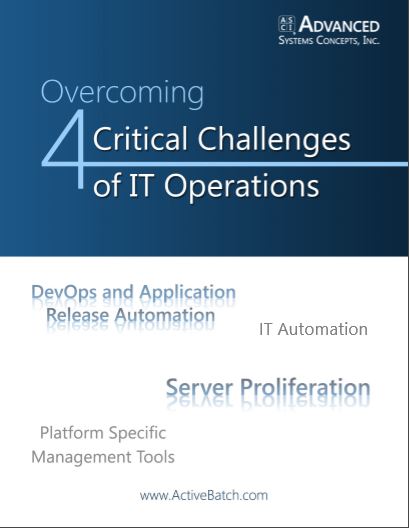Gartner’s 7 Steps to Starting Your DevOps Initiative
Manage DevOps processes with Gartner's 7 Steps to Starting Your DevOps Initiative and see how automation plays a critical role throughout DevOps.

Workload Automation and DevOps Implementation
According to the latest trends by Gartner, by the end of 2016 DevOps practices will be employed by 25% of Global 2000 organizations as part of their broader digital transformation goals. While many organizations already have some form of DevOps implementation in place, whether it be a collection of specific DevOps tools or a homegrown system, workload automation has traditionally been overlooked in the DevOps arena. With multiple siloed automation tools, DevOps practices become even more complicated and difficult to coordinate. But what many organizations don’t know is that with the right workload automation solution, they can take a consolidated approach and streamline the processes that make up a DevOps implementation and ongoing use.
DevOps is collaboration between Development and Operations teams to build, test, and correct new features and new products within companies. In many organizations, development teams work on creating, building, and evolving products to ensure the organization is up-to-date, while ops teams perform routine checks on the new products to ensure that everything is running smoothly and efficiently. The process of communication between these two departments is considered DevOps.
The process between the two teams can be extensive, tedious, and is a constant relationship. DevOps practices can be complicated, as it often means something a little different to each organization. It can be difficult to know exactly where to start with your DevOps implementation. Fortunately, Gartner has some advice.
Gartner’s 7 Steps to Starting Your DevOps Initiative
Step 1: Define DevOps For You
Gartner reports it’s critical that organizations focus on their business needs. The most important part of defining DevOps is making sure that each department is on the same page. Gartner also advises that being consistent in a DevOps approach will ensure the initiative is well-grounded and that messaging is consistent.
Step 2: Pick the Initial Team
Gartner’s report states that the key to a successful DevOps initiative is the right people. Having the right staff working on the initiative will make or break whether or not DevOps is successful. Gartner defines the right staff as people who are:
- Team Players– People who value collaboration and work well with each other
- Willing– People who understand that they may need to completely change their way of working
- Able– People capable of trying new things, taking a new approach, & widening their responsibilities.
Step 3: Pick the First Mover App
The first mover application that DevOps principles are being applied to is critical — it must demonstrate value and show your organization what works best in regards to your people, processes, technology, and information (PPTI). Gartner reports that there are no specifics in DevOps in regards to which applications you can apply DevOps concepts; however, its main use case is in agile development/ Web-enabled application development. These applications are lean, automated, and programmable — which means they are perfect for DevOps methodology. DevOps can also be used for application development with more established applications, including everything from Microsoft to open source software. Gartner advises that for the best results, IT teams should look for application development projects that are designed for change and a high tolerance for risk. You should start with a small team, and as you learn and grow, you can use your original DevOps team members to branch out and create new teams. As your teams grow, you can scale your DevOps efforts as a part of your enterprise agile initiative.
Step 4: Leverage Multiple Reference Sources
Although DevOps is your main priority in the initiative, Gartner says that you should not discount methodologies such as ITIL —which you should scale for change configuration and release in order for a successful DevOps initiative. Gartner’s guidance states that “DevOps” may be your tagline, but it shouldn’t stand alone in this transformation. Your DevOps team should work with other areas and processes such as security, architecture, and their business customers to be successful.
Step 5: Change the Objectives and Metrics
Today, most organizations take a siloed approach to departmental objectives, and IT teams are rewarded based on who resolves the problems at hand. Gartner suggests that in a DevOps initiative, objectives must be team-based and focused on the same end goal. The guidance states that you should build shared objectives that align with business needs and impacts, but more importantly organizations should help their teams understand that they need to work together. Gartner states that you should be focusing on improving your agility and business value —which they refer to as velocity and quality.
Step 6: Automate to Break Constraints
Every organization will have a different orientation from an automation standpoint. Automation technology is key in DevOps initiatives when it comes to automating workflows and manual processes and connecting disparate systems — however, many successful DevOps initiatives reap their major benefits by starting small.
Gartner reports that automation allows DevOps processes to scale and apply to larger production-oriented environments. Gartner’s guidance suggests that organizations should look at the greatest limiting constraint or pain point. Because automation improves outcomes by reducing manual intervention and therefore removing human error, activities become consistently repeatable. Make sure to look for an automation solution that can automate DevOps processes — as many aren’t designed for DevOps tools.
According to Gartner, a DevOps friendly automation tool is three things:
- DevOps-Ready, which means it offers DevOps automation functionality ‘out of the box’ and/or are built for DevOps use cases
- Devops-Enabled, meaning they are designed to work in a pipeline environment
- DevOps-Capable, they are stand-alone tools that can work in a DevOps pipeline when configured correctly. It also helps to have a tool that has been around for years
Step 7: Consider a Toolchain
While it’s important to leverage automation, it’s also critical to understand that a successful DevOps initiative should include a toolchain. Gartner reports that a successful toolchain should have each step of the DevOps process detailed with the activities associated to it. This will allow for the teams to see where automation and manual processes need to be involved within and between stages.
Gartner advises that organizations develop a “stop-the-line” mentality, meaning that if something is wrong, any member of the team can essentially pull the plug and stop it from moving forward. This will benefit your team so that you can fix problems immediately, before they grow into larger, more complex issues.
In today’s ever-changing automation environment, few organizations have learned that the end-to-end application release processes needed for the DevOps lifecycle can be automated with IT Automation, which would lessen the complexity that DevOps poses on both their development and operations teams. Using a modern IT workload automation solution, organizations can offload the manual execution of many processes to accelerate DevOps agility and free up developers and ops teams so they have time for projects of higher importance.
With automation, developers can automate routine, time-consuming build kickoffs and installations, and operations teams can build workflows that ensure machines are properly provisioning by eradicating databases and ensuring CPU is high enough to perform the tasks they need to test the features. In addition to these benefits, automation also provides the necessary scheduling capabilities that many common software delivery and development tools lack.These scheduling capabilities trigger tasks according to pre-scheduled events. This removes even more manual intervention needed from development and operations teams, providing them with time for tasks of higher importance. Workload automation is helping both dev and ops departments more efficiently build and automate stronger application development procedures, allowing DevOps to provide continuous delivery of vital new features and products to the organization.
Check out our free White Paper, Overcoming the 4 Critical Challenges of IT Operations to learn more!
Frequently Asked Questions
DevOps initiatives can vary based on an organization’s goals. It is most effectively used to build, test, and correct new features and products within a company. It brings together the operations team that are focused on running products with development teams that are working on creating, building, and evolving new products to ensure the company stays competitive.
Most DevOps leaders focus on three key pillars in their initiatives — People, Process and Product. By focusing on bringing the right people onto the team, they ensure that they can learn and follow the Agile process that is the basis for DevOps. This allows the group to focus on creating the best product delivered as quickly as possible to ensure their organization gets and keeps a competitive advantage.
Gartner defines DevOps as a new movement in IT, with a focus on rapid IT service and continuous delivery by implementing agile DevOps practices within a system-oriented approach. It’s designed to bring together operations and development teams, fostering collaboration and faster, more business-focused results. DevOps focuses on using technology, including automation solutions, to deliver projects in faster, sprint-based cycles.
Implementing a DevOps approach speeds up the continuous delivery of new projects, using the agile methodology. Projects are more closely aligned with business goals, allowing teams to more easily demonstrate their value. It helps promote collaboration between operations and development teams, ensuring that projects are well-grounded and focused on work that will help propel the organization forward.








